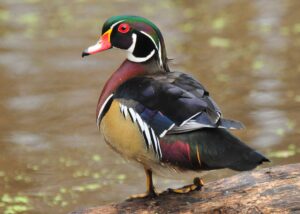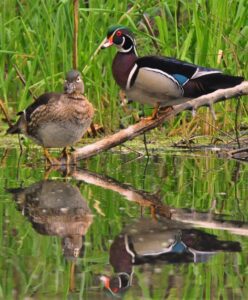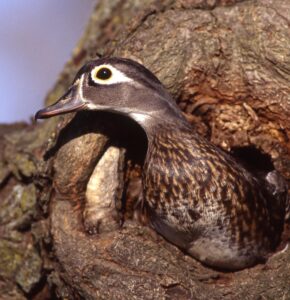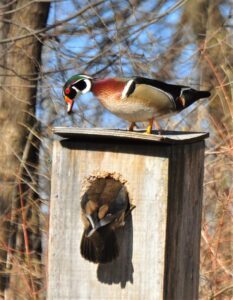Photography courtesy of Lowell Washburn, all rights reserved.
The wood duck is one of the Mississippi Flyway’s – and Iowa’s — most recreationally important waterfowl. This fact is especially true for me. During the course of a year, I spend more time hunting, observing, photographing and working with wood ducks than any other single species.

In addition to its elegantly crested head and kaleidoscope plumage, the colorful wood duck is unique from other waterfowl in many ways. Instead of communicating in familiar duck-like quacks, woodies converse through a wide range of sounds that vary from penetrating screeches, to softly spoken mews, grunts and whistles. Although I can’t site any studies to back the claim, I think wood ducks may have the most developed vocabulary of any duck. While most ducks are graceful in the air but rather clumsy on the ground, wood ducks remain agile whether on land, sea, or air. On the ground, they can run like pheasants. When foraging through the timber for grapes or late summer acorns, they can rapidly move along skinny tree branches with all the ease of a circus wire walker.

Another rather unique feature is the woodie’s unduck-like habit of nesting in elevated natural tree cavities – some as high as 50 or 60 feet above the forest floor. While the adaptation is effective, it is also dangerous. When the nests of ‘normal’ grassland nesting ducks are raided by raccoons, skunks, and ‘possums, the eggs are lost but the hen almost always escapes. By contrast, when a marauding raccoon discovers a cavity nesting wood duck, there is often no avenue of escape, resulting in the loss of both hen and eggs. The danger is illustrated by the fact that female wood ducks are subject to the highest nesting mortality of any of our duck species. But those hens that lose nests but manage to survive the attack are the most persistent renesters of any waterfowl.

Nest losses can be at least partially offset by erecting safe, predator proof nest boxes. Back in the 1970s, Cerro Gordo County Conservation Board Director, Ben Van Gundy and I had a couple of extra wood duck nest boxes that we installed at Mallard Marsh the first week of July. We didn’t expect the boxes to be used that late in the season but thought the installations would give us a head start on the next year’s nesting season. While sprucing up a number of already established boxes the following March, I decided to make sure the wood chip bedding in the two new boxes was still in good order. Much to my amazement, I discovered a complete clutch of hatched wood duck eggshells in one of the boxes. Even if a hen would have started laying eggs in the new box the same week it was installed, the ducklings wouldn’t have hatched until at least mid-August – nearly three months past peak nesting. That was one persistent hen, and her final attempt had finally paid off.


 Tom Cope
Tom Cope Sue Wilkinson
Sue Wilkinson Susan Judkins Josten
Susan Judkins Josten Rudi Roeslein
Rudi Roeslein Elyssa McFarland
Elyssa McFarland Mark Langgin
Mark Langgin Adam Janke
Adam Janke Joe Henry
Joe Henry Kristin Ashenbrenner
Kristin Ashenbrenner Joe Wilkinson
Joe Wilkinson Dr. Tammy Mildenstein
Dr. Tammy Mildenstein Sean McMahon
Sean McMahon